[ad_1]
Last week, I started telling some card-by-card design stories from Modern Horizons 2. I had more stories than could fit into a single article, so today, we get part two.
Kaldra Compleat
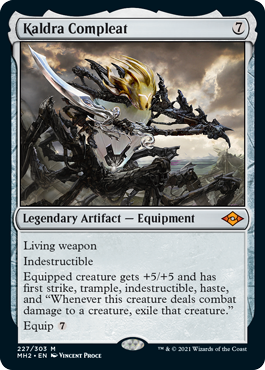
One of the cool things we get to do in a set like Modern Horizons 2 is go back to worlds we haven’t seen for a while and show what’s going on there. Last we saw New Phyrexia, the Phyrexians invaded Mirrodin and decisively won a war, but there clearly were holdouts that hadn’t yet been taken over by the Phyrexians. What if we made a card to show that the Phyrexians continued to dominate Mirrodin?
A cool way to do that is with the living weapon mechanic. It was a mechanic from Mirrodin Besieged that demonstrated how the Phyrexians were able to corrupt the equipment of the Mirrans. It would be fun to take an iconic piece of Mirrodin equipment and living-weapon it. But which one to choose?
To answer that question, I want to travel back in time to the design of original Mirrodin. Equipment first appeared in Mirrodin, and we were looking for cool things to do with it. Also, I was starting to experiment more with thinking larger than just one set. Were there cool things we could do that were more about the block as a whole rather than just one set? I had an idea.
In Mirage, there are three creatures (Breathstealer, Feral Shadow, and Urborg Panther) that, if you get them all onto the battlefield, can be sacrificed to get a creature called Spirit of the Night out of your library and put onto the battlefield. I had been a big fan of the cards and was looking for a place to do something similar.
What if we did the same kind of thing, but rather than have the cards appear all in one set, they would appear one set at a time over the course of the block?
Sword of Kaldra showed up in the first set, Mirrodin, and it just seemed like another Equipment. It was definitely one of the more powerful ones, so it was cool, but there was no sign of what was coming.
Shield of Kaldra was in the second set, Darksteel, and name-dropped Kaldra in both Sword of Kaldra and Helm of Kaldra, the latter of which was a card that didn’t exist yet. It didn’t tell you anything about what would happen if you had all three, but it hinted that there was some connection between them.
When Helm of Kaldra came out in the third set, Fifth Dawn, you could finally see what was going on. Get them all onto the battlefield, and they make a 4/4 legendary creature token that, when combined with the sword and shield, make a 9/9 creature with first strike, trample, indestructible, haste, and “whenever this creature deals combat damage to a creature, exile that creature.”
If we wanted to show how dominating the Phyrexian’s victory was over the Mirrans, how about Equipment representing the compleation of Kaldra? When you cast it, you get nearly the same creature you would get if you got out all three Kaldra Equipment cards, except that it’s an Equipment that can be moved from the 0/0 Germ to any creature you choose. We ended up with a card that is both exciting and flavorful.
Magus of the Bridge
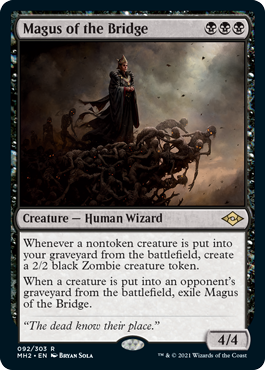
The Maguses started as a cycle in Time Spiral as a means to capture some artifacts that we couldn’t reprint because of the Reserved List. The idea behind them was that they were monocolored creatures with the same mana value as the original spell and the exact same rules text. The vulnerability of them being on a creature allowed us to print the powerful effects at the same cost as their more powerful artifact versions.
Then in Planar Chaos, the next set, we did another cycle of Maguses, this time based on powerful lands from the past.
Then in Future Sight, again the next set, we did another cycle of Maguses, this time based on powerful enchantments from the past.
The next cycle didn’t take place in one set but was stretched over five different Commander-themed products. This time, the theme focused on powerful sorceries from the past.
I bring all this up because I knew players were expecting the next Magus to be one that referenced instants, as that’s the one cycle we hadn’t done yet (technically, there are also planeswalkers, but that’s a hard card type to adapt to this structure). Magus of the Bridge didn’t actually start as a Magus; it was just a creature that did what Bridge from Below from Future Sight did, kind of.
You see, during Future Sight, we made a bunch of cards that were “futureshifted,” that is they represented cards from potential futures of Magic. They were created to tap into design space we hadn’t done much with yet. They were very hard to design, so whenever Mike Turian, the lead developer of Future Sight, got a hole for a futureshifted card slot, he would come to me to design it.
Bridge from Below and Narcomoeba were designed right near the end of development in an hour when Mike begged me for a blue and a black futureshifted card. Bridge from Below was me playing around with cards that were only active while in the graveyard. Magic had touched upon this space with the Incarnations from Judgment, and I thought it would be fun to tease us exploring more in that space.
Someone on one of the Modern Horizons 2 design teams (I don’t know whom, or I would credit them) thought it would be fun to take Bridge from Below but do the effect on a creature on the battlefield rather than on an enchantment in the graveyard. They weren’t trying to make a Magus. In fact, when the idea came to call this a Magus there was much debate, as this card deviates a bit from past Maguses in that the text is not identical to the original card. In the end, they decided it was close enough and called it a Magus.
I do want to stress two things: one, this is not necessarily the start of a new Magus cycle, and two, yes, we still might someday do the instant cycle of Maguses.
Monoskelion
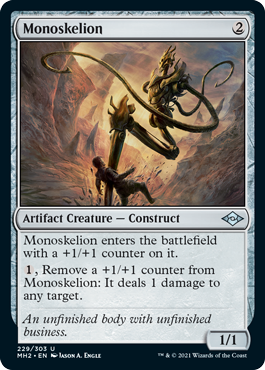
In the Modern Horizons Hackathon, I designed a five-card common cycle of “baby” creatures. Each one was a tiny version of a famous Magic creature. Of the cards in the cycle, only one card made it into Modern Horizons, a card whose design name was Baby Serra. (Ethan came up with the Segovian approach in vision design.)
After I made the cycle, Allison Steele (Allison was on the original Modern Horizons Hackathon team as well as on the Vision Design team for both Modern Horizons sets) created Monoskelion as a sixth artifact part of the cycle. Monoskelion was a riff on Triskelion from Antiquities. We had previously made Serrated Biskelion in Weatherlight as a riff.
Monoskelion was put into the Modern Horizons vision design file, but it never made it to print. While doing designs for Modern Horizons 2, Allison decided to look back at cards that had been cut from Modern Horizons and found Monoskelion. She put it into the file, and this time it stayed.
Resurgent Belief, Inevitable Betrayal, Profane Tutor, Glimpse of Tomorrow, and Gaea’s Will
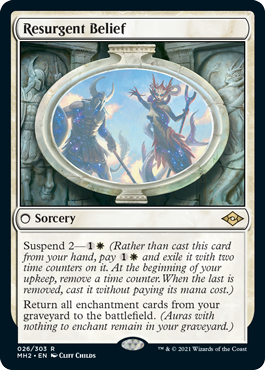
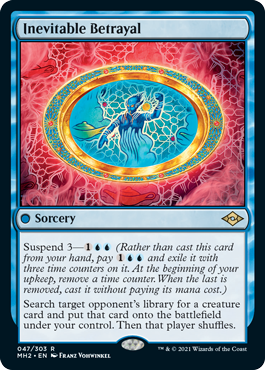
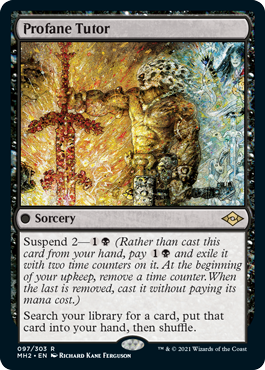
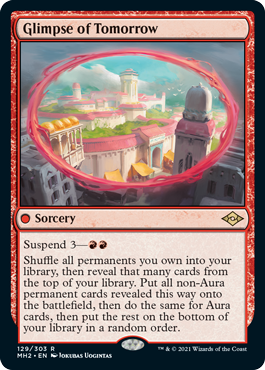
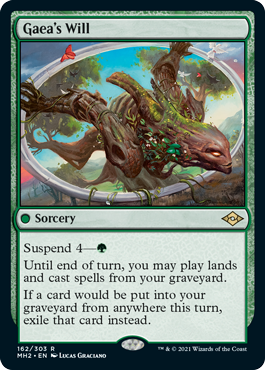
Time Spiral block mixed the theme of time with nostalgia. There’s no better example of the crossing of these themes than a rare cycle of suspend cards from Time Spiral.
All of them had no mana cost. The only way to cast them was to suspend them (i.e., pay a lower cost to cast them some number of turns in the future). One of the cool things about doing this was that we could take powerful spells from the past and allow you to cast them for the same cost.
For example, Ancestral Visions was a callback to Ancestral Recall, a card from Alpha known as being one of the “Power Nine” (nine very powerful cards that ended up getting banned or restricted in various formats). For one blue mana, you could draw three cards just like Ancestral Recall. Sure, it’s four turns from now, but even after jumping through that hoop, the card feels both exciting and nostalgic.
Modern Horizons had one such card, Crashing Footfalls, but it wasn’t a reference back to anything, so it lacked much of the coolness of the original Time Spiral cycle. Aaron and his Set Design team thought it would be fun to do a new cycle of free suspend cards.
Resurgent Belief – This card is a throwback to a card called Replenish from Urza’s Destiny. I’d really enjoyed black spells that returned all the creature cards from the graveyard to the battlefield, so I thought it would be fun to try it with a different card type. The card ended up being really good and inspired a few different decks. Unlike the original Time Spiral cycle, these designs don’t all match the original mana cost. For example, Replenish costs 3W, but Resurgent Belief’s suspend cost is only 1W.
Inevitable Betrayal – This card is a throwback to a card from Mercadian Masques called Bribery. I made it because I was intrigued to try a different kind of blue stealing spell, and this felt like a grander version. I’m not stealing something from your side of the battlefield, but from your library. Like Resurgent Belief, the card’s suspend cost is less than the original mana cost of 3UU.
Profane Tutor – This card is a throwback to Demonic Tutor, a card from Alpha. I believe this was a top-down design from Richard trying to capture the use of dark magic to get what you want. This card does match the original card’s mana cost in its activation cost. While we continue to make Demonic Tutor variants, they don’t get to cost 1B, so it’s nice that this card lets us do that.
Glimpse of Tomorrow – This card is a throwback to a card from original Ravnica called Warp World. Unlike the Time Spiral cycle, being inspired by a card doesn’t always mean it’s identical in function. For example, Warp World hits all players where Glimpse of Tomorrow only affects you. This does allow it to be significantly cheaper (RR versus Warp World’s 5RRR).
Gaea’s Will – This card is the oddest of the bunch, as green doesn’t have as many high-profile spells from the distant past (although, it’s been catching up to modern day). This card is a throwback to the card Yawgmoth’s Will from Urza’s Saga. Interestingly, during Urza’s Saga design, Mike Elliott and I both designed the same effect, but he put it in black and I put it in green. Mike was the design lead of the set, so he put his version into the file.
Aaron and I have talked about how the effect is just as much green as black (there’s even arguments on the Council of Colors that this should primarily be a green ability), so when Aaron couldn’t find a green effect he liked, he decided to colorshift the ability. Again, another way in which this cycle is a bit different from the original Time Spiral cycle. Like some of the other cards in the cycle, this card costs less than the original spell (G versus Yawgmoth Will’s 2B).
Solitude, Subtlety, Grief, Fury, and Endurance
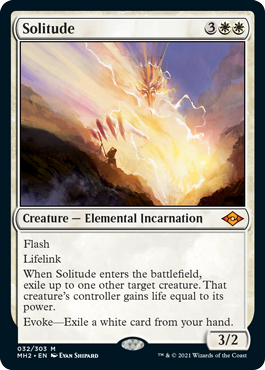
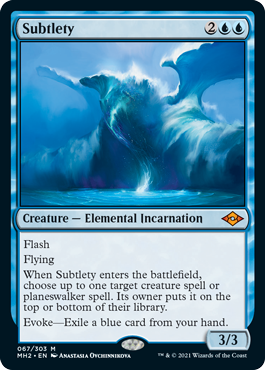
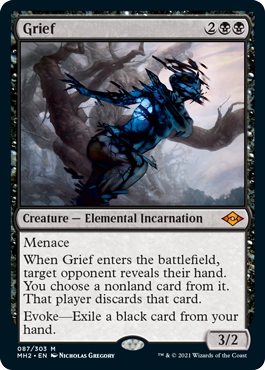
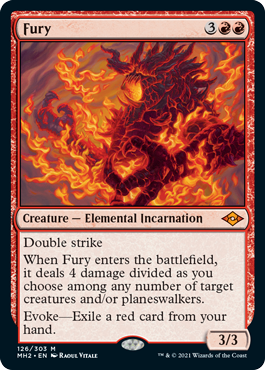
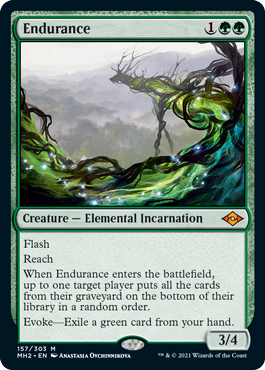
This cycle is a creation of Erik Lauer. Interestingly, it’s a combination of two different mechanics, one named, one not.
The non-named mechanic showed up first in Alliances. The design team (The East Coast Playtesters: Skaff Elias, Jim Lin, Dave Petty, and Chris Page) created a cycle of cards dubbed “pitch cards,” where you could cast the card without paying its mana cost if you instead discarded a card of the same color (a couple of the cards also required a life payment).
This cycle was very controversial at Wizards prior to the set’s release, and it even led one section of the company, Customer Service, to write a letter to the then president of the company, Peter Adkison, telling him the cards shouldn’t be printed. The cards were made and became very popular, with Force of Will becoming one of the most iconic spells in the game. Pitch spells would show up in numerous other sets (Mercadian Masques, Prophecy, Betrayers of Kamigawa, Coldsnap, and Modern Horizons).
Evoke started as a mechanic that went on instants and sorceries and turned them into creatures if you paid the extra cost. I made it because I liked the idea of spells that could be “kicked” into creatures. It turns out, though, that the rules can’t handle instants and sorceries being on the battlefield, so it was altered to be a cost on creatures that sacrificed themselves at end of turn if you didn’t pay the evoke cost. All of them had enters-the-battlefield effects to emulate the spell portion of their ability.
Erik’s idea was simple. Make evoke creatures that functioned like pitch spells—that is, keeping the creature around has a discard cost of the appropriate color rather than mana. In true Modern Horizons style, these cards could emulate spells from the past. I should note that they also have an evergreen keyword to make the creature you keep around more enticing.
Solitude
This card is a throwback to Swords to Plowshares from Alpha. Because the original spell is an instant, this spell has flash.
Subtlety
This card is less of a direct throwback. Probably the closest is Hinder from Champions of Kamigawa, but that card hit any spell, whereas Subtlety just affects creature and planeswalker spells. The creature has flash, as a counterspell must be reactive.
Grief
This card is a throwback to the card Coercion from Visions. At the time, we hadn’t added the “nonland” rider to cheap discard spells, so technically this card is Dark Inquiry from Rivals of Ixalan, but Coercion is clearly the progenitor of this type of spell.
Fury
This card is a throwback to Forked Lightning from Portal, although the more iconic spell of this effect is Arc Lightning from Urza’s Saga (it dealt 3 damage, not 4). This card is not exactly either of those effects, though, in that it can’t hit players.
Endurance
This card is a throwback to Gaea’s Blessing from Weatherlight. It’s a tweaked version, though, in that it affects all the cards in target player’s graveyard, instead of just three, and is essentially an instant and not a sorcery because the creature has flash.
Urza’s Saga
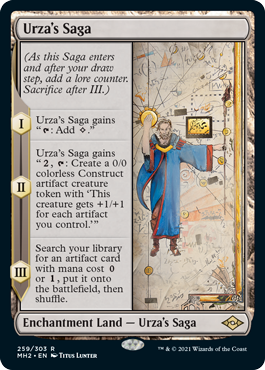
This gem of a card was also designed by Allison Steele. Allison had designed the card Mirrodin Besieged in the first Modern Horizons, and I think she was tickled by the idea of making another card whose names was that of a Magic expansion. But, instead of something easy like Tempest or Stronghold, she decided to tackle something more challenging.
I believe she chose Urza’s Saga because fellow designer Ryan Printz had pointed out that both of those words were existing subtypes. Urza’s Saga could be an Urza’s Saga. Both of those things, though, dictated a lot about the design.
First up, in order to be a Saga, it had to be an enchantment, because Saga is an enchantment subtype. Urza’s Saga wanted to tell a story anyways, so “Enchantment — Saga” felt right. The trickier thing was that the card had to also be a land because Urza’s is a land subtype.
For those unaware of the history of the Urza’s subtype, let me explain. In Antiquities, Magic‘s second-ever expansion, there was a set of three lands called Urza’s Mine, Urza’s Power Plant, and Urza’s Tower (known colloquially as the Urzatron). Each tapped for a colorless mana, but if you got all three onto the battlefield together, they produced seven colorless mana instead of three. The original versions of the cards didn’t have any subtypes, referring instead to the names of the cards.
In Eighth Edition, subtypes were added, and the rules text was changed to refer to the subtypes rather than the names. Each card was given subtypes that matched their name. Because all three cards had the word Urza’s in their name, Urza’s was made its own subtype, allowing it to be used on all three cards.
The silliness of “Urza’s” as a subtype led to many jokes from the community about it. So, not only did this card get to do something cute, but it’s playing around in a fun community meme space.
Combining land and enchantment also hit upon another popular request from the players. Ever since constellation became a thing, there have been a lot of requests for an enchantment land. Mirrodin introduced artifact lands to the game, but there has never (until now) been an enchantment land.
The card being a Saga dictated the basic structure of the card, but the abilities had to do two things: one, feel like they belonged on a land, and two, capture the rough story of Urza’s Saga.
Here’s Allison’s first attempt:
Urza’s Saga
Enchantment Land
(As this Saga enters and after your draw step, add a lore counter. Sacrifice after III.)
I – T: Add C.
II – T: Add CC.
III – T: Add CCC.
The first version mimicked the text boxes on the Urzatron lands, but it was a little light on capturing the flavor of the story.
The next version had the second ability make an Assembly-Worker (the creature type of another famous Antiquities card, Mishra’s Factory).
Finally, they got to the version that made the Construct as a nod to Urza creating Karn. That version also helped encourage you to play this card in a deck with a lot of artifacts, as being an artificer was a big part of who Urza was.
The third ability represented Urza’s inventions. The first stab had you search your library for a land that tapped for C, but that didn’t quite feel right. Urza was an artificer after all. The next version let you look for an artifact that cost nothing. Later, it was changed to zero or one. I’m pretty happy with how the final version turned out.
And with that, I finish up my Modern Horizons 2 stories. As always, I hope you enjoyed hearing the stories and look forward to any feedback you might have, be it on this article, any of the cards I talked about, or on Modern Horizons 2 itself. You can email me or contact me through any of my social media accounts (Twitter, Tumblr, Instagram, and TikTok).
Join me next week for a mailbag column where I answer your questions about Modern Horizons 2.
Until then, may you create some stories of your own with the set.
#841: Shadowmoor with Sean Fletcher
#841: Shadowmoor with Sean Fletcher
I sit down with Sean Fletcher to talk about the design of Shadowmoor.
#842: Planeswalkers, Part 2
#842: Planeswalkers, Part 2
This podcast is part two of a three-part podcast walking through every Planeswalker that’s ever gotten a card.
[ad_2]





